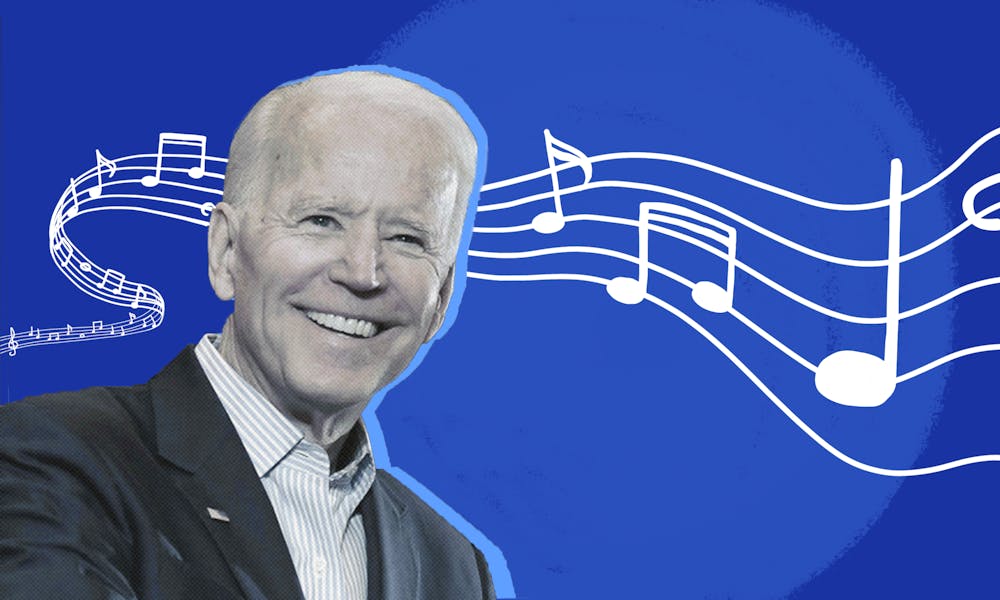American democracy is dying, and the election system is one of the fatal diseases that’s killing it. With an unnecessary emphasis on aesthetics, the spread of misinformation, inaccurate representation of voters, and a myriad of other issues, the process needs fundamental change. The cherry on top is that candidates have started to invade American ears with campaign music to discreetly shape their rhetoric and influence their audiences' emotions. Although campaign music can be used to motivate and inspire voters towards a positive direction, as Joe Biden has shown, a close look at Trump’s music choice shows that campaign music can be used to build fear and anger just as effectively.
The trend of televised campaign advertisements began with Dwight D. Eisenhower, who used Hollywood tactics to broadcast himself answering questions from ordinary Americans. To my eyes, which are accustomed to flashy modern techniques, the old ads look tacky: the camera angles are tilted and Eisenhower keeps awkwardly peering at his script. But television was new back then, so expectations were low. And his strategy worked—combined with other cunning tactics, these ads helped Eisenhower win.
Fast forward to today, where, thanks to a variety of new multimedia tools, campaign ads now use music to underscore their message. After all, music is key to capturing attention and enhancing emotions. In the 2008 election cycle, then–Senator Barack Obama released “A Mother’s Promise: Barack’s Biography,” a campaign ad with some mellow concert band music that is touching and humble, like the music that blurry old documentaries use. Combined with Obama’s narration of his childhood, the ad is proof of his humanity.
In line with his offensive strategy, President Donald Trump employed the opposite rhetoric. In 2016, his first television campaign ad featured an attack on Hillary Clinton. It started with videos of illegal immigrants and refugees in noir tone, accompanied by music with low and dissonant piano chords to strike fear in the American public. It then sharply transitioned to Trump’s plan, which naturally was accompanied by bright instrumental music—the kind you might find in inspirational playlists in YouTube—with big strokes of violin and grand brass sounds that sound fresh and exciting. It feels like a Black Mirror episode: the most powerful man in the country crushes lives and dreams while a big symphony orchestra hacks out majestic music in the background.
For the 2020 election, Trump’s strategy was similar. “America First,” a television ad that was released late August 2020, starts with heavy music and a dark tone. Booming drums and steady, heavy string strokes overlay footage of democratic candidates. Then, the video shifts into the supposed “Trump world” where everything is inspirational and constantly improving. The ad’s score mirrors this with several ascending progressions into higher notes and louder dynamics: it sounds sickeningly professional and bright. It shouts, “Look at how amazing we are!” as Black people die for being Black, hundreds of thousands die from pandemic mismanagement, and democracy erodes away.
Trump similarly aims to strike fear with his ad regarding the movement to defund the police, falsely claiming that President–elect Joe Biden wants to “reduce police funding.” The ad is almost hilariously bad, featuring a dark figure breaking into the home of an elderly woman, fearfully squinting at her TV and looking around in panic. Her 911 call goes unanswered as suspenseful music—the type you would see in nighttime crime shows—conveys doom in the background. Overall, Trump’s team tailored the campaign music to attack his opponents by instilling fear, and showcased him as a visionary candidate with appropriately majestic symphonies. His music choice exudes dominance, but is cheap, just like him.
To say Biden’s campaign music sounds different is an understatement. He doesn’t use fear tactics; his message is more about unification, which, in a dignified manner, maligns Trump. He also aims for a more inspirational, soft image, to go with his style of speech and manner. One of his ads, “Go From There,” smartly overlays warm videos of Biden and his supporters with a piano cover of the "Star Spangled Banner," picking out the sole melody line of the anthem to give a homely feel, which sharply juxtaposes the full, intense music that Trump’s team prefers. Many other videos similarly feature soft instrumentals, meant to relax the American people and provide relief—the kind of relief you feel when you know your rights are guaranteed and your life is secure.
Biden also indirectly reached out to younger audiences through TikTok. Meena Harris, Kamala Harris’ niece, did a particularly great job of reaching out to younger audiences, like her 1.4 million followers, by employing TikTok trends. She uses songs like “Lose Yo Job” by Imarkkeyz to create a meme about Trump’s defeat, “Positions” by Ariana Grande, “Papi Chulo” by Octavian & Skepta, “Stuck in the Middle” by Tai Verdes, and more. The strategy is to be trendy and relatable, and as evidenced by the 50 million likes and high turnout among young voters, Meena Harris did well.
In the end, Trump tried and failed. He used music to drum up fear and anger—childish, but smart. Maybe instead of focusing on these strategies, he should have focused on being a decent president. Either way, he lost the election, which is even more hilarious given the commanding style he shaped for himself through manipulating audio aspects of his campaign. Biden and Harris stuck to decent tactics and styles, and used music to draw pictures of hope and optimism, a strategy that, thankfully, worked.

